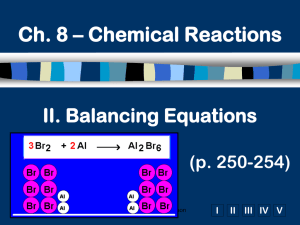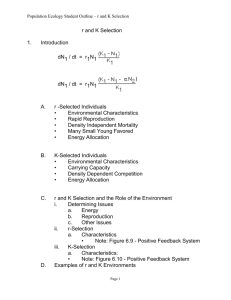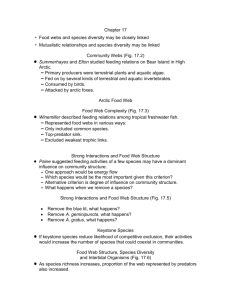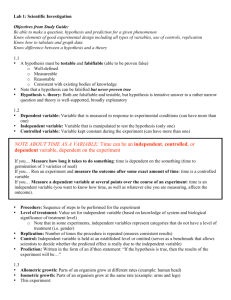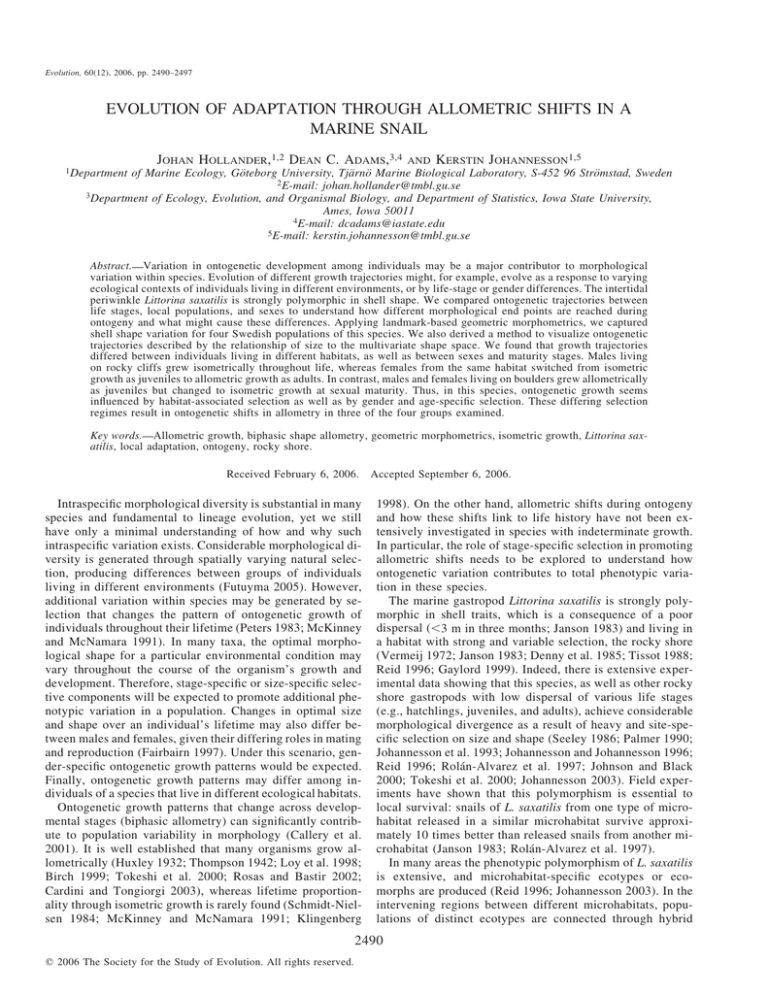
Evolution, 60(12), 2006, pp. 2490–2497
EVOLUTION OF ADAPTATION THROUGH ALLOMETRIC SHIFTS IN A
MARINE SNAIL
JOHAN HOLLANDER,1,2 DEAN C. ADAMS,3,4
AND
KERSTIN JOHANNESSON1,5
1 Department
of Marine Ecology, Göteborg University, Tjärnö Marine Biological Laboratory, S-452 96 Strömstad, Sweden
2 E-mail: johan.hollander@tmbl.gu.se
3 Department of Ecology, Evolution, and Organismal Biology, and Department of Statistics, Iowa State University,
Ames, Iowa 50011
4 E-mail: dcadams@iastate.edu
5 E-mail: kerstin.johannesson@tmbl.gu.se
Abstract. Variation in ontogenetic development among individuals may be a major contributor to morphological
variation within species. Evolution of different growth trajectories might, for example, evolve as a response to varying
ecological contexts of individuals living in different environments, or by life-stage or gender differences. The intertidal
periwinkle Littorina saxatilis is strongly polymorphic in shell shape. We compared ontogenetic trajectories between
life stages, local populations, and sexes to understand how different morphological end points are reached during
ontogeny and what might cause these differences. Applying landmark-based geometric morphometrics, we captured
shell shape variation for four Swedish populations of this species. We also derived a method to visualize ontogenetic
trajectories described by the relationship of size to the multivariate shape space. We found that growth trajectories
differed between individuals living in different habitats, as well as between sexes and maturity stages. Males living
on rocky cliffs grew isometrically throughout life, whereas females from the same habitat switched from isometric
growth as juveniles to allometric growth as adults. In contrast, males and females living on boulders grew allometrically
as juveniles but changed to isometric growth at sexual maturity. Thus, in this species, ontogenetic growth seems
influenced by habitat-associated selection as well as by gender and age-specific selection. These differing selection
regimes result in ontogenetic shifts in allometry in three of the four groups examined.
Key words. Allometric growth, biphasic shape allometry, geometric morphometrics, isometric growth, Littorina saxatilis, local adaptation, ontogeny, rocky shore.
Received February 6, 2006.
Intraspecific morphological diversity is substantial in many
species and fundamental to lineage evolution, yet we still
have only a minimal understanding of how and why such
intraspecific variation exists. Considerable morphological diversity is generated through spatially varying natural selection, producing differences between groups of individuals
living in different environments (Futuyma 2005). However,
additional variation within species may be generated by selection that changes the pattern of ontogenetic growth of
individuals throughout their lifetime (Peters 1983; McKinney
and McNamara 1991). In many taxa, the optimal morphological shape for a particular environmental condition may
vary throughout the course of the organism’s growth and
development. Therefore, stage-specific or size-specific selective components will be expected to promote additional phenotypic variation in a population. Changes in optimal size
and shape over an individual’s lifetime may also differ between males and females, given their differing roles in mating
and reproduction (Fairbairn 1997). Under this scenario, gender-specific ontogenetic growth patterns would be expected.
Finally, ontogenetic growth patterns may differ among individuals of a species that live in different ecological habitats.
Ontogenetic growth patterns that change across developmental stages (biphasic allometry) can significantly contribute to population variability in morphology (Callery et al.
2001). It is well established that many organisms grow allometrically (Huxley 1932; Thompson 1942; Loy et al. 1998;
Birch 1999; Tokeshi et al. 2000; Rosas and Bastir 2002;
Cardini and Tongiorgi 2003), whereas lifetime proportionality through isometric growth is rarely found (Schmidt-Nielsen 1984; McKinney and McNamara 1991; Klingenberg
Accepted September 6, 2006.
1998). On the other hand, allometric shifts during ontogeny
and how these shifts link to life history have not been extensively investigated in species with indeterminate growth.
In particular, the role of stage-specific selection in promoting
allometric shifts needs to be explored to understand how
ontogenetic variation contributes to total phenotypic variation in these species.
The marine gastropod Littorina saxatilis is strongly polymorphic in shell traits, which is a consequence of a poor
dispersal (⬍3 m in three months; Janson 1983) and living in
a habitat with strong and variable selection, the rocky shore
(Vermeij 1972; Janson 1983; Denny et al. 1985; Tissot 1988;
Reid 1996; Gaylord 1999). Indeed, there is extensive experimental data showing that this species, as well as other rocky
shore gastropods with low dispersal of various life stages
(e.g., hatchlings, juveniles, and adults), achieve considerable
morphological divergence as a result of heavy and site-specific selection on size and shape (Seeley 1986; Palmer 1990;
Johannesson et al. 1993; Johannesson and Johannesson 1996;
Reid 1996; Rolán-Alvarez et al. 1997; Johnson and Black
2000; Tokeshi et al. 2000; Johannesson 2003). Field experiments have shown that this polymorphism is essential to
local survival: snails of L. saxatilis from one type of microhabitat released in a similar microhabitat survive approximately 10 times better than released snails from another microhabitat (Janson 1983; Rolán-Alvarez et al. 1997).
In many areas the phenotypic polymorphism of L. saxatilis
is extensive, and microhabitat-specific ecotypes or ecomorphs are produced (Reid 1996; Johannesson 2003). In the
intervening regions between different microhabitats, populations of distinct ecotypes are connected through hybrid
2490
䉷 2006 The Society for the Study of Evolution. All rights reserved.
ALLOMETRIC SHIFTS IN LITTORINA SAXATILIS
FIG. 1. Swedish ecotypes of Littorina saxatilis. The E morph (left)
is small and thin-shelled, and has a rounded and large aperture. The
S morph (right) is larger, with a robust shell and a relatively smaller
aperture and a higher spire.
zones that include both pure ecotype snails and snails of
intermediate phenotype (Janson and Sundberg 1983; Johannesson et al. 1993; Panova et al. 2006). In rocky parts of the
Swedish west coast, for example, two ecotypes are present,
the ‘‘E’’ morph of exposed rocky cliffs and the ‘‘S’’ morph
of boulder shores (Janson 1982a). E-morph snails have low
spires, thin shells, and are small in size (Janson 1982a) (Fig.
1). These characters are believed to reduce drag forces from
waves and allow the snails to better fit into cracks and cavities
in the rock (Emson and Faller-Fritsch 1976; Raffaelli and
Hughes 1978; Hart and Begon 1982). S-morph snails are two
to four times as large as E snails and have a thick shell and
a small aperture (Janson 1982a). These traits show resistance
to crab crushing and winkling (pulling the soft parts of the
snail out of the shell through the aperture; Johannesson 1986).
The trait differences between the two ecotypes are largely
genetically fixed ontogenetic differences (Johannesson and
Johannesson 1996), although some environmentally induced
phenotypic differences are expressed during development
(Hollander et al. 2006). As a result of these observations, we
hypothesized that growth patterns might differ in this species.
From this we formulated three predictions: (1) individuals
from different environments may show different ontogenetic
growth as a result of different habitat-specific selection regimes, (2) males and females may reveal different growth
trajectories owing to gender-specific reproductive demands,
and (3) different selection regimes for juvenile and adult
individuals may promote ontogenetic shifts in growth trajectories at size of maturity.
MATERIALS
AND
METHODS
Phenotypic Data
We performed a descriptive cross-sectional allometric
analysis (Cock 1966; Klingenberg 1998) to examine sizespecific development. With this approach we separately analyzed four groups; females of the E and S morph and males
of the E and S morph from two islands. Representative samples of individuals of all sizes (⬎2 mm) of E- and
S-morph Littorina saxatilis were collected in the area around
Tjärnö Marine Biological Laboratory, on the Swedish west
coast, during the summer 2003. Snails of S morph and E
morph were sampled (50 m apart) from the island Jutholmen
2491
FIG. 2. Eight anatomical landmarks used in the morphometric
analysis.
(58⬚52.3⬘N, 10⬚59.3⬘E) and from a replicate population (again
S and E morph 50 m apart) from the island Burholmen
(58⬚51.0⬘N, 10⬚59.4⬘E) 3 km away. Earlier studies using molecular genetic markers showed that populations separated
on different islands are genetically isolated and can be considered independent populations, but samples of different
ecotypes from the same island are connected by a gene flow
and less differentiated in neutral loci than samples from distinct islands (Johannesson and Tatarenkov 1997; Johannesson et al. 2004; Panova et al. 2006).
A total of 556 specimens was used in this study; 70 males
and 70 females of each morph from each of the two islands
including both juveniles and adults (four outliers were removed). To quantify phenotypic diversity in shape we used
landmark-based geometric morphometrics (Rohlf and Marcus
1993; Adams et al. 2004; Hollander et al. 2005). Snail species
with indeterminate growth (such as Littorina saxatilis) continually accrete shell material throughout life, which poses
challenges for capturing the complete ontogenetic trajectory
and all aspects of ontogenetic shape change (Guralnick and
Kurpius 2001). However, for size-specific allometric patterns, shapes can be consistently quantified between individuals to allow comparisons of a snapshot of ontogenetic variation, and therefore such challenges are alleviated. In this
study, our aim was to analyze size-specific allometry of different life stages using size at sexual reproduction as the
reference. For this purpose, the anatomical landmarks described below provide useful means of capturing size-specific
shape variation.
We used a side view to capture shape changes in ecologically relevant traits such as aperture size and spiral volume
(although for other hypotheses, a top view might be preferable; see Guralnick and Kurpius 2001). Images of each
individual with the aperture facing upward were projected
through a camera lucida onto a digitizing tablet (Summasketch III, GTCO Calcomp, Inc., Columbia, MD), and the x,y
coordinates of eight anatomical landmarks at the surface of
the shell (Fig. 2) were recorded using DS-DIGIT (Slice 1994).
The effects of nonshape information (position, orientation,
and scale) were mathematically eliminated from these landmark configurations using a generalized Procrustes analysis
2492
JOHAN HOLLANDER ET AL.
(GPA; Rohlf and Slice 1990) which aligns all specimens and
superimposes them to a common coordinate system. From
the aligned specimens, shape variables were generated as
partial warp scores from the thin-plate spline (Bookstein
1991) and from the two standard uniform components (Bookstein 1996; Rohlf and Bookstein 2003). Together, these variables (called the weight matrix) capture all aspects of shape
variation, and can be used to test hypotheses of shape variation and covariation within and among groups using standard multivariate statistical procedures (Adams and Rohlf
2000; Adams 2004; Collyer et al. 2005). Because we were
interested in examining allometric effects on shape, we retained the size of each individual as represented by centroid
size (CSize), which is the squared root of the sum of squared
distance from each landmark to their centroid (Bookstein
1991). Finally, an additional 133 females of the S morph
(length 3.15–13.53 mm) from both of the boulder sites and
125 females of E morph (1.16–10.77 mm) from both of the
rocky sites were dissected to determine size at sexual maturation. E-morph females carrying embryos were 4 mm in
length or larger, and S-morph females were 10 mm or larger.
We used these sizes to separate juvenile and adult females,
and we also defined males as being sexually mature at these
sizes, although earlier reports sometimes indicate that males
might mature at somewhat smaller sizes than females (Reid
1996).
Statistical Analyses
To understand patterns of phenotypic diversity and patterns
of allometry, we first examined overall shape variation using
a principal component analysis (PCA) and thereafter assessed
the degree to which size influenced shell shape through allometric growth using several analyses. First, overall allometry was examined using a multivariate analysis of covariance
(MANCOVA). In this analysis, males and females of both
ecotypes (E and S) were treated as separate groups and compared, and variation in shell shape was explained in terms of
the allometric effects of body size, as well as group effects.
Data were separated by island to investigate concordance of
morphological signal among groups. We also examined patterns of allometry in different developmental stages (juveniles and adults) for each sex, morph, and island using a
multivariate regression performed on each group separately;
and each dataset was assessed for significance through a randomization procedure. Where concordances of allometric patterns were identified between islands, island groups were
pooled to increase statistical power. Finally, pairwise multiple comparisons of allometric regression vectors were performed to identify possible biphasic allometry (i.e., differences between developmental stages), and to determine
whether allometric patterns differed between ecotypes or between sexes. All analyses were performed in JMP (SAS Institute 2003), TPSRegr (Rohlf 2003), and NTSYSpc (Rohlf
2000).
RESULTS
Although snails of E and S morph were largely distinct in
shell shape, variation within ecotype revealed considerable
shape overlap between males and females and between ju-
veniles and adults, such that differences between these groups
were not at all obvious (Fig. 3). However, examining the
allometric relationships we found noticeable differences in
ontogenetic growth between the groups, and these patterns
were largely similar between snails of the same ecotype from
different populations (islands). Indeed, the MANCOVA revealed significant effects of morph, sex, and size (CSize) and
their interactions, except for the highest level of interaction
term in one population (Jutholmen), indicating that all factors
and most interactions were important to the allometric shape
of a snail (Table 1). Furthermore, rank order of importance
of main effects was morph ⬎ CSize ⬎ sex in both islands,
implying that the phenotypic signal tended to be concordant
between independent populations.
When multivariate regressions of shape versus size were
performed for each island and for each group of morph-sexdevelopmental stage separately, we found that some groups
displayed significant shell shape allometry, whereas others
showed nonsignificant allometry, that is, isometric growth
(Table 2). In six of eight comparisons these results were
consistent between islands. Therefore, we pooled data from
the two islands to increase statistical power. For adult and
juvenile females of the E morph, separate analyses of the
two islands suggested different results. However, this seemed
to be a statistical artifact rather than a description of biologically distinct allometric patterns (see below).
Analyzing the pooled data indicated that E-morph juveniles
of both sexes and adult males grew isometrically, whereas
adult females of the E morph grew allometrically (Table 3).
Although the separate statistical analysis of each island suggested different growth patterns among E-morph females, the
deformation grids displayed highly similar patterns between
islands for both juveniles and adults, strongly supporting the
overall result of the pooled data (Fig. 4). Thus, growth of Emorph males followed an isometric trajectory throughout life
whereas female E morphs switched from juvenile isometric
growth to adult allometric growth (Fig. 5). Indeed, pairwise
comparisons revealed differences in growth patterns between
E-morph female juvenile and female adult snails (F ⫽ 4.93,
df ⫽ 12,537, P ⬍ 0.0001), while no significant difference
was found between male and female juvenile growth patterns
(F ⫽ 0.53, df ⫽ 12,529, P ⫽ NS).
S-morph snails showed another allometric pattern: both
males and females displayed significant allometric growth
during the juvenile stage but switched to isometric growth
at size of maturation (Table 3). Similar to the E morph, juvenile S-morph allometry was not significantly different between sexes (F ⫽ 1.67, df ⫽ 12,529, P ⫽ NS), whereas in
both sexes adult and juvenile growth patterns differed (F ⫽
34.91, df ⫽ 12,529, P ⬍ 0.0001). Thus both females and
males of the S morph exhibited biphasic growth trajectories
with size at sexual maturation (Fig. 5). Moreover, in both
morphs juvenile development did not differ between sexes.
Notably, only E-morph males grew isometrically throughout
life.
Examining the thin-plate spline deformation grids of shape
revealed that most of the allometric changes occurred near
the aperture and at the apex of the shell (Fig. 5). Among the
adult E-morph females the most prominent change was an
extended spire volume and a somewhat decreased aperture
2493
ALLOMETRIC SHIFTS IN LITTORINA SAXATILIS
FIG. 3. Principal component analysis of variation in shell shape; 69% of the variation is expressed in the first two axes of the data
space. Light symbols represent juveniles and darker symbols represent adults. Form of datapoints indicates sex-ecotype combinations
(circle: E-morph male, square: E-morph female, diamond: S-morph male, triangle: S-morph female).
area. Similar shape deformations occurred during the juvenile
stage of S-morph development (Fig. 5). At size of maturation,
both males and females of the S morph thus attained a relatively small aperture and a voluminous spire, and these char-
TABLE 1. Multivariate analysis of covariance analyzing the phenotypic effects of morph, sex, and CSize (centroid size) for each
island separately. The phenotypic signal was similar between the
two islands, and all terms were significant except the interaction
morph ⫻ sex ⫻ CSize at Jutholmen.
Island
Source
F
df
P
morph
sex
CSize
morph ⫻ sex
morph ⫻ CSize
sex ⫻ CSize
morph ⫻ sex ⫻ CSize
58.7
5.98
6.74
5.53
2.08
4.86
3.05
12,
12,
12,
12,
12,
12,
12,
258
258
258
258
258
258
258
morph
sex
CSize
morph ⫻ sex
morph ⫻ CSize
sex ⫻ CSize
morph ⫻ sex ⫻ CSize
97.07
2.59
7.08
2.01
1.94
3.28
0.57
12,
12,
12,
12,
12,
12,
12,
261 ⬍0.0001
261
0.003
261 ⬍0.0001
261
0.02
261
0.03
261
0.0002
261
NS
Burholmen
⬍0.0001
⬍0.0001
⬍0.0001
⬍0.0001
0.02
⬍0.0001
0.0005
Jutholmen
acteristics were maintained by isometric growth during the
adult stage (Fig. 5).
DISCUSSION
Allometric growth has previously been reported in L. saxatilis, as well as in other gastropod species (Vermeij 1980;
Johannesson and Johannesson 1996; Reid 1996). Here we
show that snails of L. saxatilis show both allometric and
isometric growth and that ontogenetic growth patterns are
strongly related to microhabitat, sex, and life stage of individuals. Notably, juvenile and adult individuals may differ
in developmental patterns that result in biphasic growth trajectories. Although biphasic allometry is commonly reported
for metabolic traits (Post and Lee 1996; Glazier 2005), morphological shifts in growth trajectories are most often associated with early metamorphosis from larval to postlarval
stages in many animal species (for gastropod examples see
Vermeij 1980; Reid 1996). Additionally, shifts in the allometric growth of morphological traits at sexual maturity have
rarely been reported. Furthermore, sustained isometric
growth during an organism’s lifetime is seldom observed in
nature (Schmidt-Nielsen 1984; McKinney and McNamara
1991; Klingenberg 1998). Our result supports this generalization, as we found only periods of isometric growth in three
of four groups of L. saxatilis (male and female S-morph and
female E-morph). Interestingly, though, males of E morph
revealed isometric growth throughout life.
2494
JOHAN HOLLANDER ET AL.
TABLE 2. The results of multivariate regression analyses indicating
allometric (P ⬍ 0.05) or isometric (nonsignificant) development.
Data is analyzed separately for each of the different morph-sexdevelopmental stages, and for each island separately. Bold numbers
indicate significant regression. A dash denotes no value, as sample
size was too small for a meaningful statistical test.
Island
Group
F
df
P
Burholmen
E
E
E
E
S
S
S
S
female juvenile
female adult
male juvenile
male adult
female juvenile
female adult
male juvenile
male adult
3.27
2.29
1.76
1.866
4.58
—
3.8
—
12, 22
12, 22
12, 21
12, 23
12, 44
—
12, 45
—
0.008
0.04
0.12
0.09
0.0001
—
0.0005
—
E
E
E
E
S
S
S
S
female juvenile
female adult
male juvenile
male adult
female juvenile
female adult
male juvenile
male adult
0.978
1.42
2.3
0.756
5.06
1.3
2.64
2.04
12,
12,
12,
12,
12,
12,
12,
12,
0.49
0.22
0.06
0.68
0.0001
0.35
0.01
0.16
TABLE 3. Multivariate tests of allometry of pooled data for each
group of sex, ecotype, and developmental stage in Littorina saxatilis.
Nonsignificant tests (NS) indicate isometric growth.
Group
E
E
E
E
S
S
S
S
female juvenile
female adult
male juvenile
male adult
female juvenile
female adult
male juvenile
male adult
P randomization
NS
0.0083
NS
NS
⬍0.0001
NS
⬍0.0001
NS
Growth pattern
isometric
allometric
isometric
isometric
allometric
isometric
allometric
isometric
Jutholmen
20
24
17
27
35
9
36
8
A variety of factors may influence ontogenetic shell
growth. For example, ontogenetic growth may be under genetic control, environmentally induced, or, most likely, influenced by both factors. Common-garden and transplant
studies have shown that genetic variation is a dominant component of differences in shell shape and size between ecotypes of L. saxatilis (Janson 1982b; Johannesson and Johannesson 1996; Johannesson et al. 1997). From these results
we infer that differences in developmental patterns between
the two Swedish ecotypes of L. saxatilis is largely inherited
and molded by local selection to increase individual fitness
of snails of different sex and age living in different microhabitats. Viewed from a biomechanical perspective, the distinct ontogenetic patterns among snail groups that we identified may be explained in terms of specific and differing
evolutionary forces inferred from knowledge about the relationships between physical and biotic forces and shell shape
and size. For instance, in shores where wave action is a dominating selective factor for snail survival, shell morphologies
are formed to minimize drag (small size, low spire) and maximize attachment (a large aperture and foot; Reid 1996; Trussell and Etter 2001; Johannesson 2003). Here, drag force
generated by the moving water can be expressed as;
FHyd ⫽ A1 ⫻ U2 ⫻ h,
(1)
where FHyd is the drag, A1 is the cross-sectional area exposed
by the organism against the flow, U2 is the velocity of the
moving fluid, and h is the drag coefficient (Denny 1988).
Thus the force acting on the snail is simply proportional to
the cross-sectional area of the snail. Furthermore, the strength
with which an organism is able to attach to the substratum
depends on the area against the substratum. For a snail, this
strength is proportional to the area of the foot, rendering a
capacity of adhesion of:
FAdd ⫽ h ⫻ A2,
(2)
FIG. 4. Deformations grids illustrating E-morph female growth
development at each of two islands: Burholmen and Jutholmen.
Snail’s positions as in Figure 2. Because there was no obvious
difference between ontogenetic growth of snails from the two islands, neither at juvenile (a), nor at adult (b) stages we pooled
island data also for this group of snails.
ALLOMETRIC SHIFTS IN LITTORINA SAXATILIS
2495
FIG. 5. Pseudo-allometry plot, with centroid size (the squared root of the sum of squared distance from each landmark to their centroid)
as the x-axis and relative warp 1 (RW; equivalent to PC) as the y-axis. The minimum and maximum centroid size values are shown for
each group, and the average of a subset of small and large specimens for each group generated the y-value. The groups are: E-morph
male (circle), E-morph female (square), S-morph male (diamond), S-morph female (triangle). Juveniles are open symbols and adults are
shaded gray. Thin-plate spline deformation grids are accentuated by a factor of 3. Snail’s positions as in Figure 2.
where FAdd is the force of adhesion, A2 is the area against
the substratum, and h is the coefficient of adhesion (Denny
1988). Consequently, both drag and adhesion are directly
proportional to area (length squared), and an isometric development will maintain a favorable relationship between
aperture area and cross-sectional area when snails grow larger, keeping the risk of dislodgement constant over snail sizes.
For E-morph males, wave action is likely to be the dominant ecological selective force, and it may explain their isometric growth throughout life. Interestingly, foot size in the
closely related species Littorina obtusata has an isometric
relationship with size in wave-exposed sites, but not in more
protected sites (Trussell 1997).
Although female snails of the E morph live under similar
wave-selection conditions, the isometric growth promoting
resistance to wave forces is likely counterbalanced by allometric growth promoting increased fecundity in mature females. The observed switch to allometric growth at the size
of maturity is consistent with a mechanism to increase reproductive output by expanding spire volume and giving
room for more embryos (Reid 1996; Ilano et al. 2004). In-
deed, volume of the shell spire of adult E-morph females was
significantly larger than males’ spire volume (⬎3%, P ⬍
0.03) for individuals of similar sizes, whereas differences
between male and females of the other groups (S adults, S
juveniles, E juveniles) were nonsignificant (P ⬎ 0.05).
In different habitats, boulders protect snails from wave
exposure, and thus selection that promotes isometric growth
to resist waves is likely weak in boulder-rich habitats. Instead, the high densities of crabs in these environments and
increased evidence of crab attacks (as observed by shellrepaired morphology: see Johannesson 1986) indicate that
shore crabs exert important selection on shell size and shape
on boulder shores (Reid 1996; Trussell and Etter 2001). Boulder shore S-morph snails grow rapidly to attain a large and
thick shell (Johannesson and Johannesson 1996), and crab
attack success rate appears to decrease with an increase in
snail size (Elner and Raffaelli 1980; Johannesson 1986).
However, as snails increase their shell size, an alternative
attack technique is used by the crabs; instead of breaking the
shell they insert a claw through the aperture and pull out the
soft parts of the snail (Johannesson 1986). Snails may gain
2496
JOHAN HOLLANDER ET AL.
protection from winkling by diminishing aperture size relative to shell size as they grow larger (Johannesson 1986), or
by expanding spire height allowing withdrawal of the soft
parts into the shell, out of reach of crabs (DeWitt et al. 2000).
The allometric growth of juvenile S-morph snails indeed
tends to decrease aperture size and expand spire height (Fig.
5), but at size of sexual maturity snails switch to isometric
growth. One possible explanation for this switch to isometric
growth may be that increased allometric growth results in
shell spires that are too high, which consequently increases
the risk of crab damage. Support for this is found in L. obtusata, where high-spired snails living in crab-free environments on the American east coast lost their spires after shore
crabs invaded the area (Seeley 1986).
Although additional experimental studies are needed to
sort out the relationship between habitat-related selection and
ontogenetic growth patterns of ecotypes, we found that the
developmental patterns were largely repeated in independent
populations of crabs in similar habitats. Notably, recent studies show that local populations of distinct ecotypes of L.
saxatilis evolve in situ and that populations of similar ecotype
from different areas evolve in parallel (Johannesson 2001;
Rolán-Alvarez et al. 2004; Panova et al. 2006). This suggests
that the specific allometries have similarly evolved in parallel
across these separate populations. If so, this provides additional support for the different ontogenetic developmental
pathways being shaped by natural selection. We suggest that
researchers have overlooked the importance of developmental shifts in the evolution of species with indeterminate
growth, and we recommend further studies be performed to
better understand what might be a fundamental component
of organic evolution.
ACKNOWLEDGMENTS
This project was sponsored in part by the National Science
Foundation (grant DEB-0446758 to DCA); the Swedish Research Council; the European Commission (contract EVK3CT-2001-00048 to KJ); and Rådman och Fru Ernst Collianders Stiftelse, Ebba och Sven Schwartz Stiftelse, and Stiftelserna Wilhelm och Martina Lundgrens Vetenskapsfond (to
JH). We thank two anonymous reviewers for helpful comments during the preparation of this report.
LITERATURE CITED
Adams, D. C. 2004. Character displacement via aggressive interference in Appalachian salamanders. Ecology 85:2664–2670.
Adams, D. C., and F. J. Rohlf. 2000. Ecological character displacement in Plethodon: biomechanical differences found from a geometric morphometric study. Proc. Natl. Acad. Sci. USA 97:
4106–4111.
Adams, D. C., F. J. Rohlf, and D. E. Slice. 2004. Geometric morphometrics: ten years of progress following the ‘‘revolution.’’
Ital. J. Zool. 71:5–16.
Birch, J.-M. 1999. Skull allometry in the marine toad, Bufo marinus.
J. Morphol. 241:115–126.
Bookstein, F. L. 1991. Morphometric tools for landmark data: geometry and biology. Cambridge Univ. Press, Cambridge, U.K.
———. 1996. Combining the tools of geometric morphometric. Pp.
131–151 in L. F. Marcus, M. Corti, A. Loy, G. J. P. Naylor, and
D. E. Slice, eds. Advances of morphometrics. NATO ASI Series
A: Life sciences. Vol. 284. Plenum, New York.
Callery, E. M., H. Fang, and R. P. Elinson. 2001. Frogs without
polliwogs: evolution of anuran direct development. Bioessays
23:233–241.
Cardini, A., and P. Tongiorgi. 2003. Yellow-bellied marmots (Marmota flaviventris) ‘‘in the shape space’’ (Rodentia, Sciuridae):
sexual dimorphism, growth and allometry of the mandible.
Zoomorphology 122:11–23.
Cock, A. G. 1966. Genetic aspects of metrical growth and form in
animal. Q. Rev. Biol. 41:131–190.
Collyer, M. L., J. M. Novak, and C. A. Stockwell. 2005. Morphological divergence of native and recently established populations
of White Sands pupfish (Cyprinodon tularosa). Copeia 2005:1–
11.
Denny, M. W. 1988. Biology and the mechanics of the wave-swept
environment. Princeton Univ. Press, Princeton, NJ.
Denny, M. W., T. L. Daniel, and M. A. R. Koehl. 1985. Mechanical
limits to size in wave-swept organisms. Ecol. Monogr. 55:
69–102.
DeWitt, T. J., B. W. Robinson, and D. S. Wilson. 2000. Functional
diversity among predators of a freshwater snail imposes an adaptive trade-off for shell morphology. Evol. Ecol. Res. 2:129–148.
Elner, R. W., and D. G. Raffaelli. 1980. Interactions between two
marine snails, Littorina rudis Maton and Littorina nigrolineata
Gray, a predator, Carcinus maenas (L.) and a parasite, Microphallus similis Jägerskiöld. J. Exp. Mar. Biol. Ecol. 43:151–160.
Emson, R. H., and R. J. Faller-Fritsch. 1976. An experimental investigation into the effect of crevice availability on abundance
and size-structure in a population of Littorina rudis (Maton):
Gastropoda: Prosobranchia. J. Exp. Mar. Biol. Ecol. 23:285–297.
Fairbairn, D. J. 1997. Allometry for sexual size dimorphism: pattern
and process in the coevolution of body size in males and females.
Annu. Rev. Ecol. Syst. 28:659–687.
Futuyma, D. J. 2005. Evolution. Sinauer Associates, Sunderland,
MA.
Gaylord, B. 1999. Detailing agents of physical disturbance: waveinduced velocities and accelerations on a rocky shore. J. Exp.
Mar. Biol. Ecol. 239:85–124.
Glazier, D. S. 2005. Beyond the ‘‘3/4-power law’’: variation in the
intra- and interspecific scaling of metabolic rate in animals. Biol.
Rev. 80:611–662.
Guralnick, R., and J. Kurpius. 2001. Spatial and temporal growth
patterns in the phenotypically variable Littorina saxatilis: surprising patterns emerge from chaos. Pp. 195–227 in M. L. Zelditch, ed. Beyond heterochrony: the evolution of development.
Wiley-Liss, New York.
Hart, A., and M. Begon. 1982. The status of general reproductive
strategy theories, illustrated in winkles. Oecologia 52:37–42.
Hollander, J., M. Lindegarth, and K. Johannesson. 2005. Local adaptation but not geographic separation promotes assortative mating in a snail: support for ecological speciation. Anim. Behav.
70:1209–1219.
Hollander, J., M. L. Collyer, D. C. Adams, and K. Johannesson.
2006. Phenotypic plasticity in two marine snails: constraints
superseding life history. J. Evol. Biol. 19:1861–1872.
Huxley, J. 1932. Problems of relative growth. Dial Press, New York.
Ilano, A.-S., K. Fujinaga, and S. Nakao. 2004. Mating, development
and effects of female size on offspring number and size in the
neogastropod Buccinum isaotakii. (Kira, 1959). J. Molluscan
Stud. 70:277–282.
Janson, K. 1982a. Phenotypic differentiation in Littorina saxatilis
Olivi (Mollusca, Prosobranchia) in a small area on the Swedish
west coast. J. Molluscan Stud. 48:167–173.
———. 1982b. Genetic and environmental effects on the growth
rate of Littorina saxatilis Olivi. Mar. Biol. 69:73–78.
———. 1983. Selection and migration in two distinct phenotypes
of Littorina saxatilis in Sweden. Oecologia 59:58–61.
Janson, K., and P. Sundberg. 1983. Multivariate morphometric analysis of two varieties of Littorina saxatilis from the Swedish west
coast. Mar. Biol. 74:49–53.
Johannesson, B. 1986. Shell morphology of Littorina saxatilis Olivi:
the relative importance of physical factors and predation. J. Exp.
Mar. Biol. Ecol. 102:183–195.
Johannesson, B., and K. Johannesson. 1996. Population differences
in behaviour and morphology in the snail Littorina saxatilis:
ALLOMETRIC SHIFTS IN LITTORINA SAXATILIS
phenotypic plasticity or genetic differentiation? J. Zool. 240:
475–493.
Johannesson, K. 2001. Parallel speciation: a key to sympatric divergence. Trends Ecol. Evol. 16:148–153.
———. 2003. Evolution in Littorina: ecology matters. J. Sea Res.
49:107–117.
Johannesson, K., and A. Tatarenkov. 1997. Allozyme variation in
a snail (Littorina saxatilis): deconfounding the effects of microhabitat and gene flow. Evolution 51:402–409.
Johannesson, K., B. Johannesson, and E. Rolán-Alvarez. 1993. Morphological differentiation and genetic cohesiveness over a microenvironmental gradient in the marine snail Littorina saxatilis.
Evolution 47:1770–1787.
Johannesson, K., E. Rolán-Alvarez, and J. Erlandsson. 1997.
Growth rate differences between upper and lower shore ecotypes
of the marine snail Littorina saxatilis (Olivi) (Gastropoda). Biol.
J. Linn. Soc. 61:267–279.
Johannesson, K., J. Lundberg, C. André, and P. G. Nilsson. 2004.
Island isolation and habitat heterogeneity correlate with DNA
variation in a marine snail (Littorina saxatilis). Biol. J. Linn.
Soc. 82:377–384.
Johnson, M. S., and R. Black. 2000. Associations with habitat versus
geographic cohesiveness: size and shape of Bembicium vittatum
Philippi (Gastropoda: Littorinidae) in the Houtman Abrolhos
Islands. Biol. J. Linn. Soc. 71:563–580.
Klingenberg, C. P. 1998. Heterochrony and allometry: the analysis
of evolutionary change in ontogeny. Biol. Rev. 73:79–123.
Loy, A., L. Mariani, M. Bertelletti, and L. Tunesi. 1998. Visualizing
allometry: geometric morphometrics in the study of shape changes in the early stages of the two-banded sea bream, Diplodus
vulgaris (Perciformes, Sparidae). J. Morphol. 237:137–146.
McKinney, M. L., and K. J. McNamara. 1991. Heterochrony: the
evolution of ontogeny. Plenum Press, New York.
Palmer, A. R. 1990. Predator size, prey size, and the scaling of
vulnerability: Hatchling gastropods versus barnacles. Ecology
71:759–775.
Panova, M., J. Hollander, and S. K. Johannesson. 2006. Site-specific
genetic divergence in parallel hybrid zones suggests nonallopatric evolution of reproductive barriers. Mol. Ecol. 15:
4021–4031.
Peters, R. H. 1983. The ecological implications of body size. Cambridge Univ. Press, Cambridge, U.K.
Post, J. R., and J. A. Lee. 1996. Metabolic ontogeny of teleost
fishes. Can. J. Fish. Aquat. Sci. 53:910–923.
Raffaelli, D. G., and R. N. Hughes. 1978. The effects of crevice
size and availability on populations of Littorina rudis and Littorina neritoides. J. Anim. Ecol. 47:71–83.
Reid, D. G. 1996. Systematics and evolution of Littorina. The Ray
Society, London.
2497
Rohlf, F. J. 2000. NTSYSpc. Ver. 2.10p. Exeter Software, Applied
Biostatistics, Setauket, NY.
———. 2003. tpsRegr, shape regression. Ver. 1.28. Department of
Ecology and Evolution, State University of New York, Stony
Brook, NY.
Rohlf, F. J., and F. L. Bookstein. 2003. Computing the uniform
component of shape variation. Syst. Biol. 52:66–69.
Rohlf, F. J., and L. F. Marcus. 1993. A revolution in morphometrics.
Trends Ecol. Evol. 8:129–132.
Rohlf, F. J., and D. Slice. 1990. Extensions of the Procrustes method
for the optimal superimposition of landmarks. Syst. Zool. 39:
40–59.
Rolán-Alvarez, E., K. Johannesson, and J. Erlandsson. 1997. The
maintenance of a cline in the marine snail Littorina saxatilis: the
role of home site advantage and hybrid fitness. Evolution 51:
1838–1847.
Rolán-Alvarez, E., M. Carballo, J. Galindo, P. Moran, B. Fernandez,
A. Caballero, R. Cruz, E. G. Boulding, and K. Johannesson.
2004. Nonallopatric and parallel origin of local reproductive
barriers between two snail ecotypes. Mol. Ecol. 13:3415–3424.
Rosas, A., and M. Bastir. 2002. Thin-plate spline analysis of allometry and sexual dimorphism in the human craniofacial complex. Am. J. Phys. Anthropol. 117:236–245.
SAS Institute. 2003. JMP. Ver. 5.1. SAS Institute, Inc. Cary, NC.
Schmidt-Nielsen, K. 1984. Scaling: why is animal size so important? Cambridge Univ. Press, Cambridge, U.K.
Seeley, R. H. 1986. Intense natural selection caused a rapid morphological transition in a living marine snail Littorina obtusata.
Proc. Natl. Acad. Sci. USA 83:6897–6901.
Slice, D. E. 1994. DS-DIGIT: basic digitizing software. Department
of Ecology and Evolution, State University of New York, Stony
Brook, NY.
Thompson, D. A. W. 1942. On growth and form. Cambridge Univ.
Press, Cambridge, U.K.
Tissot, B. N. 1988. Geographic variation and heterochrony in two
species of cowries (Cypraea). Evolution 42:103–117.
Tokeshi, M., N. Ota, and T. Kawai. 2000. A comparative study of
morphometry in shell-bearing molluscs. J. Zool. 251:31–38.
Trussell, G. C. 1997. Phenotypic plasticity in the foot size of an
intertidal snail. Ecology 78:1033–1048.
Trussell, G. C., and R. J. Etter. 2001. Integrating genetic and environmental forces that shape the evolution of geographic variation in a marine snail. Genetica 112:321–337.
Vermeij, G. J. 1972. Intraspecific shore-level size gradients in intertidal molluscs. Ecology 53:693–700.
———. 1980. Gastropod shell growth rate, allometry, and adult
size: environmental implications. Pp. 379–394 in D. C. Rhoads
and R. A. Lutz, eds. Skeletal growth of aquatic organisms: biological records of environmental change. Plenum Press, New
York.
Corresponding Editor: D. Ó Foighil

